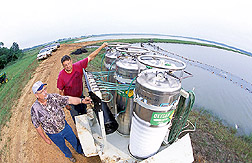| 
Click image for caption and other photo
information.
Read the
magazine
story to find out more.
|
Liquid Oxygen
Saves Channel Catfish During Harvest
By Jim Core
August 7, 2003 An improved method for supplying
farm-raised catfish with sufficient oxygen during a crucial production stage
has been co-developed by an Agricultural
Research Service scientist.
Farm-raised channel catfish are harvested with long nets pulled by tractor
and hydraulic net reels. In harvesting's final stages, fish are concentrated in
net "socks" at high densities and often held overnight to allow
smaller, submarketable fish to slip out through the sock mesh.
To provide oxygen, water is slowly moved through the sock with
tractor-powered or electric paddle wheel aerators. However, this also increases
water velocity through the sock, adding to the metabolic oxygen demand of the
fish, which are further crowded to facilitate loading on a transport truck.
This additional stress often results in several hundred pounds of dead fish
arriving at the plant.
Les Torrans, a research fishery biologist with ARS' Catfish
Genetics Research Unit in Stoneville, Miss., says a new system called
the "Sock Saver" means more live fish could make it to market.
He designed and built equipment to use liquid oxygen (LOX) during harvest
with Charles D. Hogue, Jr., of the Mississippi
State University Extension Service, and Sam Pilkinton of Columbus,
Miss., a catfish farmer and live hauler.
Most private live haulers and fingerling producers now use LOX on their
transport trucks, and many farmers use it on their farm trucks when moving fish
from pond to pond. The Sock Saver, a small trailer holding three 50-gallon LOX
tanks, is hauled behind a pickup truck or a small tractor around commercial
ponds to wherever fish are being harvested. Hoses are used to inject pure
oxygen through diffusers into a slow water current moving through the sock,
increasing dissolved oxygen by as much as 0.9 milligrams per liter.
Research also shows that increasing dissolved oxygen results in
faster-growing fish. Techniques for using LOX in ponds during the production
cycle will be developed soon.
Read more
about this research in the August issue of Agricultural Research
magazine.
ARS is the U.S. Department of
Agriculture's chief scientific research agency.
|